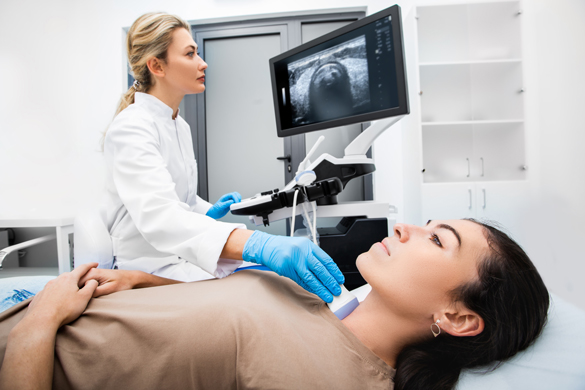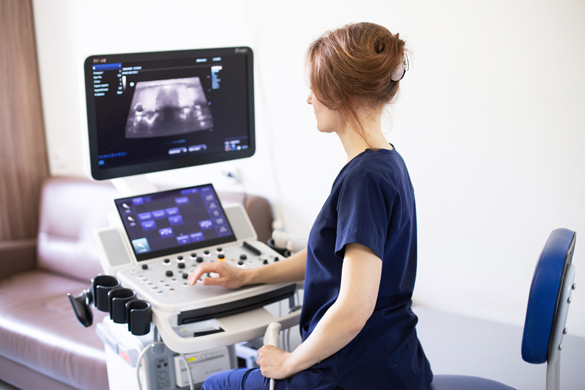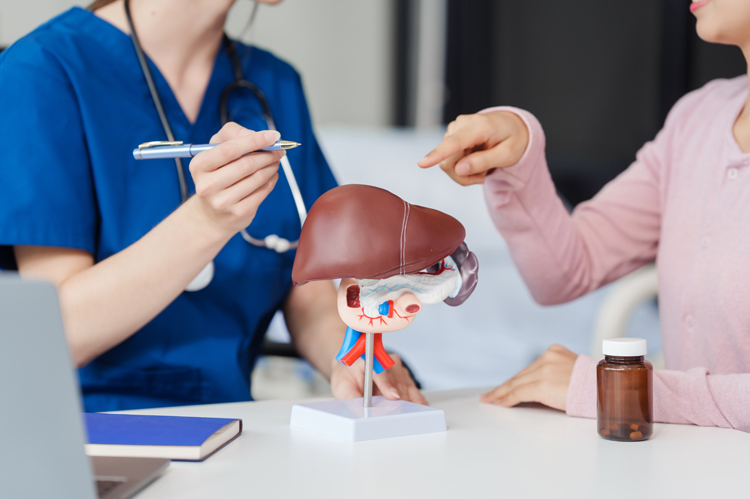Course Descriptions
- Once accepted into the DMS Program, all courses for the major must be completed with a grade of 78% or better.
 Download the DMS Associate in Science Degree 2025 PROGRAM MAP.
Download the DMS Associate in Science Degree 2025 PROGRAM MAP.
NC.DMS100: Introduction to the Field of Sonography
Explore a career in medical imaging by learning about the field of Diagnostic Medical Sonography. The course provides students with a foundational understanding of the history and scope of ultrasound, sound physics, basic sonographic principles, the hospital environment, and patient care fundamentals tailored to diverse populations. Students will also explore accreditation standards and regulatory requirements within the field. Upon completion, students will be prepared for further study in diagnostic medical sonography.
DMS101: Patient Care Techniques for Sonographers (2 Units)
Introduces fundamental patient care techniques for sonographers, emphasizing effective communication, safety protocols, infection control, and ethical and legal responsibilities. Students learn to address patients' physical and emotional needs during sonographic procedures, providing care for diverse populations, including pediatric, geriatric, and obstetric patients. This course prepares students for real-world patient care scenarios in clinical practice. Admission to the Diagnostic Medical Sonography program is required.
DMS 102: Sectional Anatomy for Sonographers (2 Units)
Provides a detailed study of human cross-sectional anatomy for diagnostic medical sonography. Students explore anatomical structures in sagittal, coronal, and transverse planes, focusing on the abdomen, pelvis, thorax, and extremities. Emphasis is placed on understanding the relationships between organs, tissues, muscles, and vessels, and how these appear in sonographic images. By correlating anatomy with imaging, students prepare for accurate image acquisition and interpretation in clinical practice. Admission to the Diagnostic Medical Sonography program is required.

DMS 110: Abdominal Sonography with Lab (6 Units)
Examines the anatomy, physiology, and pathology of abdominal organs and superficial structures as seen through diagnostic sonography. Students learn to identify normal and abnormal sonographic appearances, optimize image acquisition, and apply scanning techniques. Emphasis is placed on interpreting images of the liver, gallbladder, pancreas, spleen, kidneys, thyroid, scrotum, and vascular structures. Hands-on labs provide practical experience with real-time ultrasound equipment, refining scanning techniques, patient positioning, and transducer selection for standard abdominal protocols. Admission to the Diagnostic Medical Sonography program is required.
DMS 115: Vascular Sonography I: Introduction to Venous Systems with Lab (3 Units)
Provides exploration of sonographic evaluations of the venous system, emphasizing Doppler techniques applied to the venous systems of both the upper and lower extremities. The curriculum covers essential topics such as the normal anatomy of veins, hemodynamic principles, and common venous pathologies including deep vein thrombosis (DVT), venous insufficiency, and varicosities. Laboratory sessions offer practical experience in venous Doppler scanning, focusing on techniques for optimizing images and recognizing pathological conditions. Admission to the Diagnostic Medical Sonography program is required.
DMS 120: Obstetric and Gynecologic Sonography with Lab (6 Units)
Examines the anatomy, physiology, and pathology of the female reproductive system and fetal development as seen through diagnostic sonography. Students learn to identify anatomical variations, sonographic appearances, and pathologies, applying sonographic techniques for obstetric and gynecological exams. This includes assessing fetal gestational age, anatomy, and pathology, along with associated maternal conditions. The course covers clinical symptoms, sonographic appearances, scanning techniques and protocols, and lab tests. Hands-on labs provide practical experience with real-time ultrasound equipment, refining scanning techniques, patient positioning, and transducer selection for standard pelvic exams. Admission to the Diagnostic Medical Sonography program is required.
DMS 125: Vascular Sonography II: Introduction to Arterial Systems with Lab (3 Units)
Introduces sonographic evaluation of the arterial system, focusing on carotid and peripheral arterial imaging. Students learn standard arterial anatomy, hemodynamics, and Doppler principles. Emphasis is placed on identifying normal anatomy, blood flow, and common pathologies. Hands-on labs introduce carotid and arterial scanning skills, including basic Doppler waveform analysis. Admission to the Diagnostic Medical Sonography program is required.

DMS 130: Ultrasound Physics and Instrumentation (4 Units)
Provides a comprehensive exploration of the fundamental principles of ultrasound physics as applied to diagnostic medical sonography and focuses on developing an understanding of sound wave propagation, transducer technology, the Doppler effect, image formation, and artifacts. Students will analyze key topics such as sound-tissue interaction, attenuation, resolution, bioeffects, and quality assurance in ultrasound imaging. Through a structured approach, students will apply concepts, analyze relationships between physical principles and clinical practices, and evaluate ultrasound images and quality assurance methods. This course is essential for building the technical foundation required to perform and interpret sonographic exams. Admission to the Diagnostic Medical Sonography program is required.
DMS 200: Advanced Sonographic Practices with Lab (2 Units)
Explores advanced topics and scanning practices in diagnostic medical sonography. Students will demonstrate an in-depth understanding of advanced sonographic scanning techniques for Abdomen and Superficial Structures, Obstetrics and Gynecology, and Pediatrics. Emphasis will be placed on refining and optimizing both routine and complex protocols, enhancing image acquisition techniques, and increasing scanning speed and accuracy. Students will also apply critical thinking to improve diagnostic skills and clinical efficiency. Extensive hands-on experience with advanced scanning protocols will help students synthesize didactic and clinical knowledge to improve clinical outcomes. This course is essential for evaluating and enhancing the skills required for a positive clinical experience. Admission to the Diagnostic Medical Sonography program is required.
DMS 240: Sonography Clinical Education I (7 Units)
Introduces students to the clinical environment, focusing on departmental organization, patient flow, and PACS (Picture Archiving and Communication Systems) procedures to meet accreditation competency requirements. Students observe clinical sonographic techniques, engage in hands-on scanning, and practice fundamental protocols in the abdomen and superficial structures, obstetrics and gynecology, and vascular imaging. The course integrates patient communication, cultural competency, patient care protocols, and compliance with Health Insurance Portability and Accountability Act (HIPAA) regulations. This is the first course in the three-part clinical education sequence. Admission to the Diagnostic Medical Sonography program is required.
DMS 240: Sonography Clinical Education II (3.5 Units)
Provides continued clinical education, allowing students to perform sonographic examinations with increased autonomy under clinical instructor supervision to meet accreditation competency requirements. Students refine scanning techniques in the abdomen and superficial structures, obstetrics and gynecology, and vascular imaging while enhancing image quality, efficiency, and diagnostic accuracy. The course focuses on patient care, clinical workflow, image acquisition, and diagnostic interpretation. This is the second course in the three-part clinical education sequence. Admission to the Diagnostic Medical Sonography program is required.
DMS 240: Sonography Clinical Education III (9 Units)
Provides continued clinical education, allowing students to enhance their experience in developing sonographic scanning competency under clinical supervision. Students refine exam techniques, working towards independent competency and accreditation requirements. The focus is on abdomen & superficial structures, obstetrics & gynecology, and vascular protocols. Students integrate patient care and utilize clinical tools like Picture Archiving and Communication System (PACS), enhancing their practical application of sonographic procedures. This is the third course in the three-part clinical education sequence. Admission to the Diagnostic Medical Sonography program is required.
DMS270: Registry Review (2 Units)
Provides comprehensive reviews of program presented sonography material, preparing students for ARDMS (American Registry for Diagnostic Medical Sonography) and ARRT (American Registry of Radiologic Technologists) registry exams in Abdomen/Superficial Structures and Obstetrics/Gynecology. Topics include key concepts, test-taking strategies, and the application of clinical and didactic knowledge to case studies and practice exams. Students reinforce their understanding through targeted reviews, focusing on essential topics for successful certification. Admission to the Diagnostic Medical Sonography program is required.

 My Canyons
My Canyons  Canvas
Canvas 
